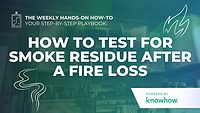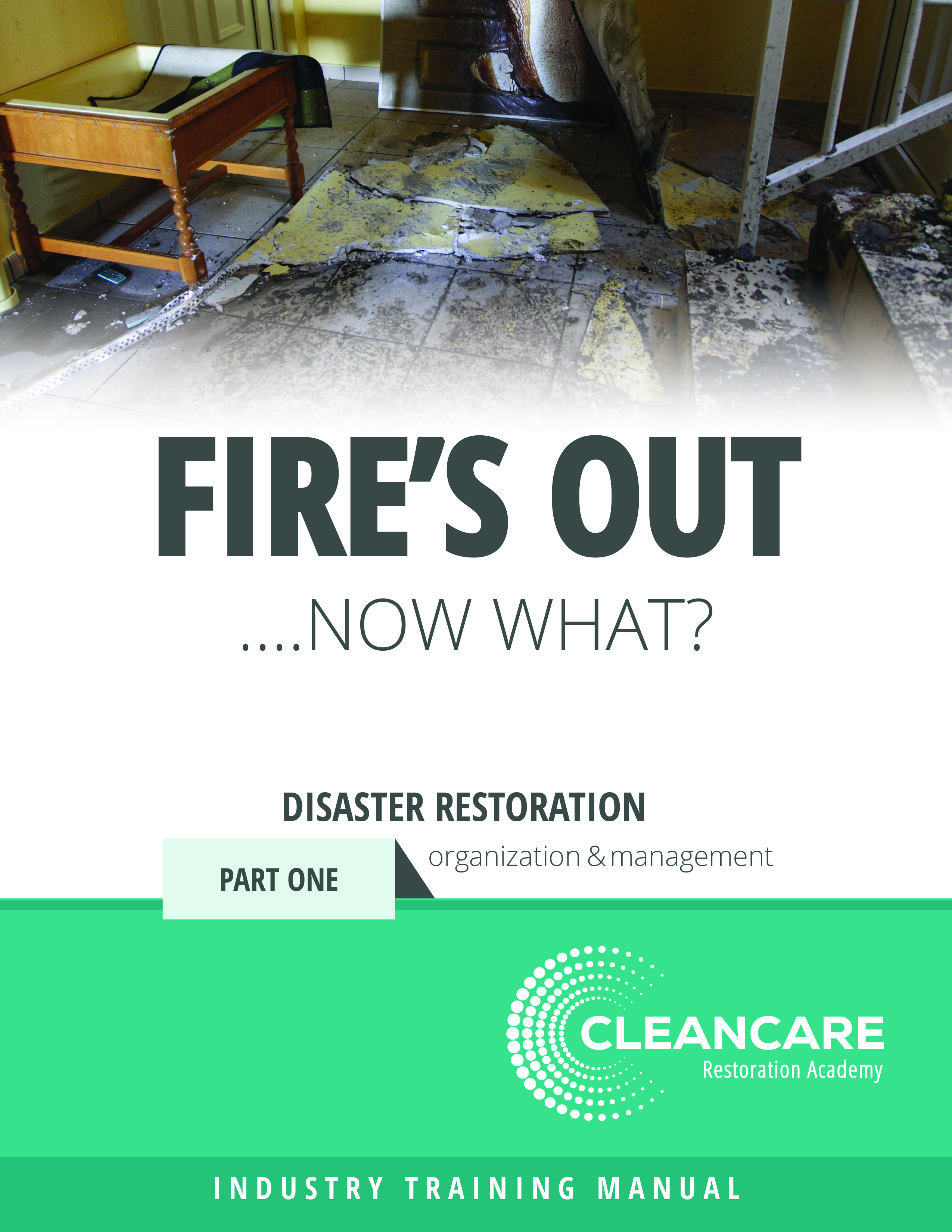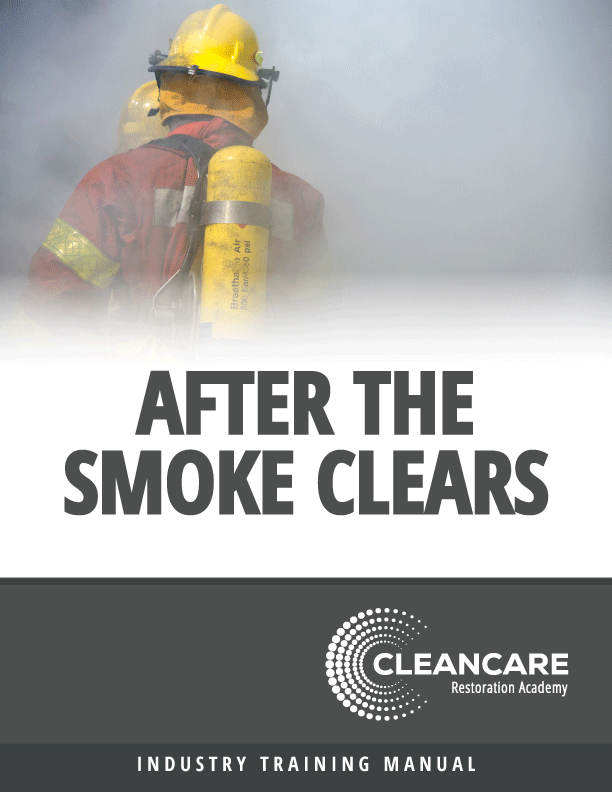Weekly Hands-on How-To powered by KnowHow
How to Oversee a Fire Restoration Project
10 Essential Steps to Rebuild with Confidence and Precision

Restoring a property after a fire is no small feat. When homeowners face the aftermath of a blaze, they're not just dealing with physical damage and financial burden—they’re grappling with the emotional weight of seeing their belongings and memories turned to ash.
But where does their path to recovery begin? That’s where restorers come in. In this weekly how-to, powered by KnowHow, we’ll break down each step of the fire cleaning process that you need to know so you and your teams can confidently restore these properties and the lives of your clients.
So, let’s get started and walk through the general principles and best practices for restoring any fire-damaged property.
Note: This Weekly Hands-On How-To is based on this template in KnowHow’s template library.
Step 1: Use Appropriate Personal Protective Equipment (PPE)
When dealing with fire-damaged properties, always prioritize your team’s safety by using proper personal protective equipment (PPE). The remnants of a fire will often contain sharp debris, harmful chemicals, soot, and other contaminants that pose serious health risks.
-
Use Appropriate PPE: Wear goggles, gloves, masks, and protective clothing to shield yourself from hazardous materials. Goggles shield your eyes from airborne particles, gloves protect against direct contact with harmful substances, and masks filter out chemicals and fine particulates. Learn how to properly don and doff PPE here.
- Check Condition and Fitting: PPE must fit correctly to be effective. Before starting, check that all gear is secure and in good condition. Loose or damaged equipment leaves you vulnerable to exposure. Read more on how to inspect PPE here.
Step 2: Conduct a Site Inspection for Safety
Fire-damaged properties often have poor air quality and compromised structural integrity. To ensure your safety before restoration, identify any potential job site hazards by conducting a site inspection. When conducting the site inspection, pay particular attention to:
-
Air Quality Concerns: Before beginning your walk around, ensure the area has been ventilated thoroughly and consider setting up air scrubbers to filter out harmful particles. Always wear appropriate respiratory protection, like N95 masks or respirators.
-
Structural Integrity: Check for any signs of structural damage that could pose risks to you or your team. Weakened structural support beams and foundations are common among heavy-damaged structures.
-
Debris and Hazards: Look for broken glass, sharp objects, and other debris that could cause injury. Always wear proper footwear, such as steel-toed boots, to protect against these dangers.
- Slip and Fall Hazards: Standing water, oil spills, and soot or ash can all increase the risk of slips and falls and may even hide exposed electrical wiring.
Step 3: Assess the Extent of the Damage
Before diving into the cleaning process, take time to assess the full extent of the fire damage. Understanding the scope of the damage helps you determine the level of cleaning required and identify any areas needing special attention. Some common damage types include:
-
Smoke Damage: Check for staining or discoloration on walls, ceilings, and surfaces caused by smoke residues. Smoke also leaves behind particulate matter and a lingering odor that requires specialized deodorization techniques.
-
Soot Residue: Soot can settle on all surfaces, from furniture to electronics, and can cause permanent staining if not addressed promptly. There are different types of soot (e.g., dry soot from fast-burning fires, oily soot from slow-burning fires), each requiring a specific cleaning approach.
-
Water Damage: Firefighting efforts often result in water damage to walls, floors, and personal belongings. Look for signs of water saturation, warping, or mold growth, which can further compromise the structural integrity and indoor air quality.
-
Heat Damage: Examine areas near the fire's source for signs of warping, charring, or melted materials. Extreme heat can weaken building materials, making them more susceptible to collapse.
- Structural Damage: Assess for compromised beams, supports, or walls that may have lost their load-bearing capacity. This can pose serious safety risks and should be addressed before any cleaning or restoration begins.

Step 4: Ventilate the Area
Before starting the detailed cleaning process, you need to ventilate the property thoroughly. Proper ventilation helps remove smoke odors, reduces airborne toxins, and improves overall air quality. This step is essential to creating a safer environment for your team and preparing the space for deeper restoration efforts.
-
Maximize Air Circulation: Open all windows and doors throughout the affected area to create cross-ventilation, allowing fresh air to circulate and push out lingering smoke particles and odors. If the property has multiple floors, start by ventilating the upper levels first, as smoke tends to rise and accumulate in these areas.
-
Deploy Ventilation Equipment: Use high-powered fans and air movers strategically placed near open windows and doors to expedite the exchange of indoor and outdoor air. This helps to speed up the removal of smoke, odors, and airborne contaminants.
-
Utilize Air Scrubbers: Set up air scrubbers equipped with HEPA filters in the most affected areas. These devices capture 99.97% of airborne particles, including soot and ash, down to 0.3 microns in size. If available, consider using air scrubbers with activated carbon filters to help neutralize smoke odors and chemical fumes.
- Check HVAC Systems: If the HVAC system was running during or after the fire, it may have spread smoke and soot throughout the property. Inspect and clean all HVAC components, including ducts and filters, to prevent further contamination and ensure optimal air quality.
Step 5: Remove Debris and Ash
After ventilating the area, begin removing debris, ash, and charred items to prepare the space for more detailed cleaning. Keep an eye out for personal items that can be recovered and document and store these according to your company’s guidelines.
-
Use HEPA Vacuums: Use HEPA-filter vacuums to capture fine particles and soot. As you clean and move items, harmful particles will be kicked up. Continue using HEPA vacuums throughout this stage to prevent contaminants from becoming airborne again.
- Handle Debris and Items with Care: Debris may contain hazardous materials like sharp objects or harmful chemicals. Wear proper PPE and dispose of debris carefully to avoid exposure or injury.
Step 6: Identify the Type of Fire Cleaning Required
Different fire incidents leave behind various types of residues, and using the right cleaning method is crucial for effective restoration. Each type of fire—whether fast-burning, slow-burning, or smoldering—creates specific challenges that require tailored solutions.
-
Assessment: Examine the affected areas and materials, such as walls, ceilings, floors, and furniture. Pay attention to the type and extent of residue present and any structural damage that may complicate the cleaning process.
-
Categorization: Determine the type of fire (e.g., fast-burning, slow-burning) and the materials affected (e.g., porous surfaces, delicate fabrics).
- Guidelines: Follow industry standards to choose the appropriate cleaning procedures, ensuring safety and effectiveness. In cases of complex or extensive damage, consulting with an IICRC-certified professional can be beneficial.
Step 7: Gather Necessary Cleaning Supplies
Having the right cleaning supplies at your disposal is crucial for a successful fire cleanup. Each type of residue and material will require specific tools and products.
-
Soot Removal Sponges: Also known as “chem sponges,” these vulcanized rubber sponges are designed to physically remove soot from surfaces without the use of water or chemicals. These are ideal for initial dry cleaning on walls, ceilings, and other flat surfaces.
- Solvents and Chemicals: For acidic smoke residues, use alkaline-based cleaning products to neutralize the pH. For oily or greasy residues, select appropriate solvents that can dissolve these contaminants effectively without damaging the underlying material.

Step 8: Clean Surfaces
After removing debris and ventilating the area, it’s time to tackle the detailed cleaning of surfaces affected by smoke and soot. This step is crucial to eliminate residual contaminants and restore the property’s appearance.
-
Cleaning Techniques: To effectively clean different surfaces, employ various methods such as agitation, lubrication, and temperature control.
-
Cleaning Mixture: For general cleaning, mix a mild detergent with warm water. Always start with a gentler solution and escalate to stronger cleaners if necessary.
-
Scrubbing Technique: Use a soft cloth or sponge to gently scrub the affected areas. Avoid aggressive scrubbing, as this can drive soot deeper into the surface or spread it. Focus on small sections at a time, and rinse your cleaning tool frequently to prevent reapplying soot.
- Specialized Cleaners: For stubborn or oily residues, use cleaners specifically formulated for fire damage restoration. Products such as degreasers or alkaline solutions can break down the sticky or greasy soot left behind by certain types of fires.
Step 9: Clean Fabrics and Upholstery
Fabrics and upholstery often absorb smoke and soot, requiring special attention during fire restoration.
-
Laundering: For washable fabrics like curtains, clothing, and linens, use a specialized smoke-odor detergent in the washing machine. Run multiple cycles if needed to fully eliminate odors and residues.
-
Vacuuming: For upholstered furniture, use a vacuum with an upholstery attachment to gently lift away soot and debris. Be thorough in vacuuming all surfaces, including seams and crevices, to ensure no particles are left behind.
- Professional Help: If your contents facility cannot handle very delicate fabrics, intricate textiles, or items that are heavily soiled, enlist the help of a specialized contents company.
Step 10: Eliminate Smoke Odor
Finally, address any lingering smoke odors to fully restore the property’s air quality.
-
Odor Absorbers: Use baking soda, activated charcoal, or commercial products to absorb odors.
-
Ozone Generators: For persistent odors, consider using ozone generators or seeking professional odor removal subcontractors.
- Air Scrubbers: Deploy air filtration devices with carbon filters to cleanse the air effectively.

Conclusion
Armed with these fire cleaning principles, you’re not just restoring properties—you’re helping homeowners regain a sense of normalcy after devastating losses. By mastering these steps, you can confidently tackle one of the toughest challenges in restoration: fire damage.
But with so many details to remember, it’s easy to feel overwhelmed, and it’s not always easy to get a hold of a manager to guide you through the process. That’s where KnowHow comes in. The KnowHow platform, available on desktop and mobile, offers instant, on-the-job guidance to ensure your team is equipped and prepared for any situation.
Visit tryknowhow.com to discover how we can support your restoration crews and help you turn even the most chaotic scenarios into easy step-by-step processes.
Looking for a reprint of this article?
From high-res PDFs to custom plaques, order your copy today!





.jpg?height=200&t=1712776413&width=200)


